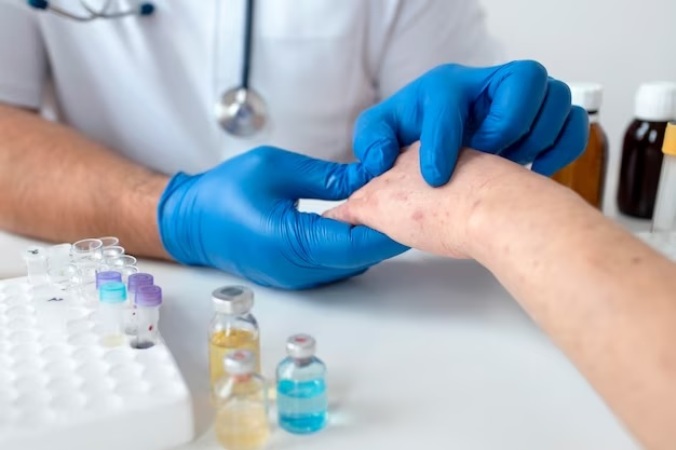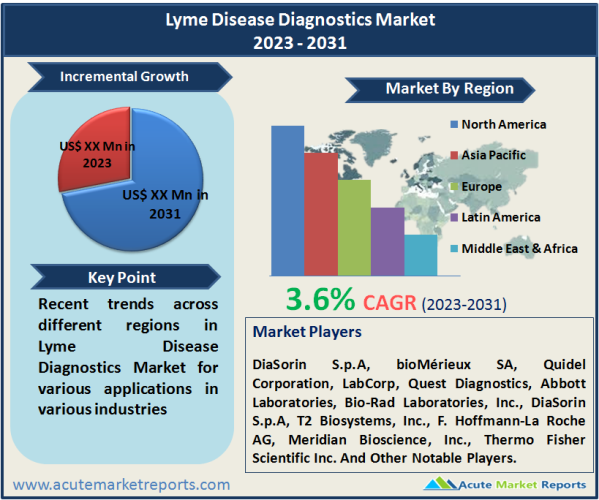
The lyme disease diagnostics market plays a pivotal role in the early detection and treatment of Lyme disease, a vector-borne illness caused by the bacterium Borrelia burgdorferi. The lyme disease diagnostics market is expected to grow at a CAGR of 3.6% during the forecast period of 2025 to 2033, driven by the increasing incidence of Lyme disease, advancements in diagnostic technologies, and growing awareness. Despite the limitations in early-stage diagnosis, PCR tests are expected to lead in terms of CAGR. Geographic trends are shifting, with emerging hotspots in regions like Europe. Leading companies are focused on innovation, geographic expansion, and educational efforts to maintain their competitive edge in this dynamic market, ensuring timely and accurate diagnosis for Lyme disease patients.

Increasing Incidence of Lyme Disease
A primary driver of the lyme disease diagnostics market is the escalating incidence of Lyme disease, particularly in regions where ticks carrying Borrelia burgdorferi are prevalent. Evidence of this trend can be found in the rising number of reported Lyme disease cases globally. The disease's expansion into new geographic areas, driven by factors like climate change and increased outdoor activities, emphasizes the need for early and accurate diagnostics. This has led to a surge in demand for serological tests, polymerase chain reaction (PCR) tests, and other diagnostic methods for Lyme disease.
Advancements in Diagnostic Technologies
Advances in diagnostic technologies have significantly enhanced the lyme disease diagnostics market. Innovations in serological tests, PCR assays, and culture techniques have improved the accuracy and reliability of Lyme disease diagnosis. For example, the development of multiplex PCR assays enables simultaneous detection of multiple Borrelia species, contributing to more precise and timely diagnosis. Evidence of this progress can be seen in the increasing adoption of nucleic acid amplification tests (NAATs) for Lyme disease diagnosis, which offer superior sensitivity.
Growing Awareness and Early Detection Initiatives
The growing awareness of Lyme disease and initiatives to promote early detection have been instrumental in driving the market. Public health campaigns, healthcare provider education, and community outreach efforts emphasize the importance of recognizing early symptoms, such as erythema migrans (bull's-eye rash), and seeking a prompt diagnosis. This has led to a higher rate of early-stage Lyme disease diagnoses, fostering demand for diagnostic tests. Evidence of this can be observed in the decrease in cases diagnosed at later stages when the disease can be more challenging to treat.
Restraint of the lyme disease diagnostics market
While the lyme disease diagnostics market shows promise, a significant restraint is the limitations of current diagnostic methods, particularly in the early stages of the disease. Evidence of this challenge can be seen in cases where serological tests may yield false-negative results in the initial weeks after infection, as the patient's immune response may not have produced detectable antibodies. This diagnostic gap underscores the need for ongoing research and development efforts to enhance the sensitivity and specificity of early Lyme disease diagnostics, ensuring accurate detection and timely treatment.
Market Segmentation by Diagnostic Test (Serological Test, PCR Test, Others): Serological Tests Dominate the Market
In 2024, the highest revenue within the lyme disease diagnostics market was generated by serological tests, given their widespread use for Lyme disease screening. However, during the forecast period from 2025 to 2033, PCR tests are expected to exhibit the highest compound annual growth rate (CAGR). This growth is attributed to the increasing adoption of molecular diagnostic methods for Lyme disease, which offer greater sensitivity and specificity, particularly in the early stages of infection.
Market Segmentation by Sample (Blood, Cerebrospinal Fluid, Others): Blood Samples Dominate the Market
In 2024, blood samples accounted for the highest revenue within the lyme disease diagnostics market, as they are commonly used for serological and molecular diagnostic tests. However, during the forecast period from 2025 to 2033, cerebrospinal fluid samples are expected to experience the highest CAGR. This shift is driven by the growing recognition of neurological complications associated with Lyme disease, necessitating more frequent testing of cerebrospinal fluid for accurate diagnosis.
North America Remains as the Global Leader
Geographically, the lyme disease diagnostics market exhibits varying trends. North America, particularly the northeastern United States, has traditionally been a significant hotspot for Lyme disease cases. However, regions like Europe and parts of Asia are witnessing an increasing incidence of Lyme disease. These geographic trends are influenced by climate change, habitat changes, and increased awareness of the disease. The region with the highest revenue percentage in 2024 was North America, given its historical burden of Lyme disease cases. However, regions with emerging Lyme disease hotspots, such as parts of Europe, are expected to demonstrate the highest CAGR during the forecast period. These regions are experiencing a surge in reported cases and increased demand for Lyme disease diagnostics.
Innovation Remains as the Key to Enhane Market Share
The lyme disease diagnostics market is characterized by the presence of several key players who continually strive to innovate and provide accurate diagnostic solutions. Leading companies in this market include DiaSorin S.p.A, bioMérieux SA, Quidel Corporation, LabCorp, Quest Diagnostics, Abbott Laboratories, Bio-Rad Laboratories, Inc., DiaSorin S.p.A, T2 Biosystems, Inc., F. Hoffmann-La Roche AG, Meridian Bioscience, Inc., and Thermo Fisher Scientific Inc. Leading companies are investing in research and development to create novel diagnostic assays that improve the accuracy and specificity of Lyme disease diagnosis. These efforts include the development of advanced serological tests, PCR assays, and nucleic acid amplification techniques. Companies are expanding their geographic footprint by entering new markets and regions with an increasing incidence of Lyme disease. This expansion allows them to cater to a broader customer base and respond to the growing demand for diagnostic tests. Collaboration with research institutions, public health agencies, and healthcare providers is a strategic move for companies in the lyme disease diagnostics market. These partnerships facilitate the development of new diagnostic technologies and enhance market penetration. Leading players are actively engaged in awareness and educational initiatives to increase knowledge about Lyme disease and the importance of early diagnosis. These initiatives aim to empower both healthcare providers and the general public in recognizing and addressing the disease.
Historical & Forecast Period
This study report represents analysis of each segment from 2023 to 2033 considering 2024 as the base year. Compounded Annual Growth Rate (CAGR) for each of the respective segments estimated for the forecast period of 2025 to 2033.
The current report comprises of quantitative market estimations for each micro market for every geographical region and qualitative market analysis such as micro and macro environment analysis, market trends, competitive intelligence, segment analysis, porters five force model, top winning strategies, top investment markets, emerging trends and technological analysis, case studies, strategic conclusions and recommendations and other key market insights.
Research Methodology
The complete research study was conducted in three phases, namely: secondary research, primary research, and expert panel review. key data point that enables the estimation of Lyme Disease Diagnostics market are as follows:
Market forecast was performed through proprietary software that analyzes various qualitative and quantitative factors. Growth rate and CAGR were estimated through intensive secondary and primary research. Data triangulation across various data points provides accuracy across various analyzed market segments in the report. Application of both top down and bottom-up approach for validation of market estimation assures logical, methodical and mathematical consistency of the quantitative data.
| ATTRIBUTE | DETAILS |
|---|---|
| Research Period | 2023-2033 |
| Base Year | 2024 |
| Forecast Period | 2025-2033 |
| Historical Year | 2023 |
| Unit | USD Million |
| Segmentation | |
Diagnostic Test
| |
Sample
| |
End-User
| |
|
Region Segment (2023-2033; US$ Million)
|
Key questions answered in this report